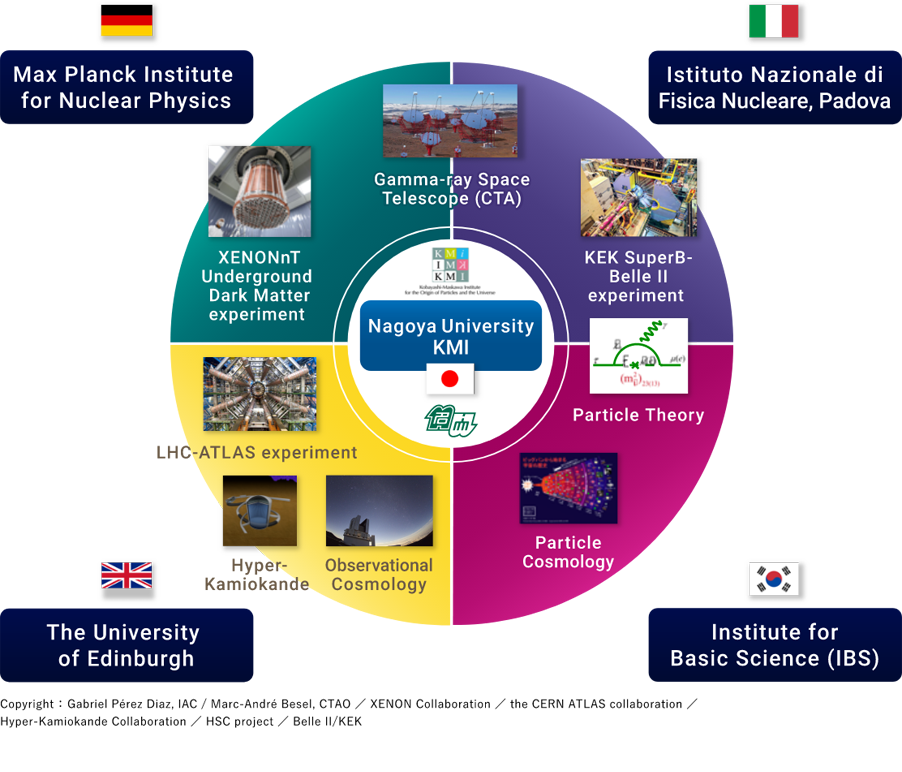共同研究
Research
R1
LHCを用いた暗黒物質素粒子生成の研究
Studies of Dark Matter Productions using the LHC
LHC ATLAS実験において暗黒物質の直接生成事象の探索を行います。エジンバラ大学の若手含む研究者グループとともに、暗黒物質として有望視されている超対称性粒子の対生成やジェット対共鳴状態という相補的な暗黒物質粒子生成を探索します。暗黒物質検出専用トリガーの新規開発を行い、未探索の信号に感度のある事象の収集を可能します。2022-2024 年に取得するデータを使い、本事業期間内にデータ解析結果を公表します。
We perform searches for direct productions of Dark Matter at the LHC-ATLAS experiment. Together with the researchers at the University of Edinburgh, we develop complementary search-methods, for instance, in jet-pair resonances and in the productions of supersymmetric particles, which are considered as one of the promising Dark-Matter candidates. Our research also covers the developments of new triggers for Dark-Matter detections, which enable us to take events sensitive to unexplored signals. We expect various physics results using the LHC Run 3 data (2022-2024).
R2
B中間子精密測定実験による暗黒物質の探索
Search for Dark Matter in the B-meson precision-measurement experiment
2024年までにKEK Belle実験の10倍を超えるデータを蓄積、10の11乗個以上のB中間子、タウレプトンなどを用いて新物理探索を進めます。暗黒物質の候補となりうる物理の質量探索領域は10-100TeV に達します。また暗黒物質に崩壊する未知粒子の探索結果を得ます。検出器の性能やデータ解析効率の改良を進め、探索感度の改良を進めます。
In the Belle II experiment, we collect a 10 times larger dataset than that in the Belle experiment. We perform searches for new physics phenomena using more than 1011 B-mesons and tau-leptons. The mass range sensitive to dark matter candidates reaches 10–100 TeV. We obtain the search results of unknown particles decaying to Dark Matter. We improve the performance of the detector and the data-taking efficiency, as well as the search sensitivity.
R3
暗黒物質の直接探索実験
Detections of Dark Matter in Underground Experiments
マックスプランク研究所とINFN ボローニャの共同研究者と共に、グランサッソー研究所でのXENONnT実験により暗黒物質の直接探索を行います。特にボローニャグループとは暗黒物質の背景事象となる中性子を除去する検出器の建設と運用を行います。またエジンバラ大学とスーパー及びハイパーカミオカンデにおけるニュートリノ研究を行います。
We perform direct detection of dark matter in the XENONnT experiment at GranSasso Laboratory Italy in collaboration with MPIK, INFN Bologna and other partner institutes. We collaborate with Bologna, Mainz and Rome groups to construct and operate the neutron veto detector which will play an essential role to reject major neutron background events for dark matter signals. We also conduct neutrino experiments in Super-Kamiokande and Hyper-Kamiokande in collaboration with University of Edinburgh and King’s College London.
R4
暗黒物質からの宇宙ガンマ線観測
Observations of Gamma Ray from Dark Matter
INFNパドヴァの研究者とガンマ線望遠鏡であるFermi衛星のデータ解析を進め、暗黒物質対消滅起源のガンマ線を探します。また、チェレンコフ テレスコープアレイ(CTA)計画は次世代ガンマ線望遠鏡であるが、そのカメラ開発の中心であるマックスプランク研究所とカメラの較正手法を確立します。中口径望遠鏡の光検出器を電子管から半導体に代替し感度向上を目指します。マックスプランク研究所と共同でカメラの試作機を製作、試験観測を通して設計を検証します。本事業期間中に望遠鏡を設置、観測を開始します。
Researchers at INFN Padova and KMI work together to search for gamma-ray signals from annihilation of dark matter by analyzing the gamma-ray data from the Fermi gamma-ray satellite. We also collaborate with Max Planck Institute at Heidelberg (MPIK) to establish calibration procedures for the camera of small-sized telescopes for the next generation gamma-ray instrument, Cherenkov Telescope Array (CTA). We also explore improvement of the sensitivities by replacing phototubes with silicon photomultipliers of large-sized and medium-sized telescopes. MPIK and KMI team plans to produce a prototype camera and verify the performance by observation campaigns. In the duration of this project, most telescopes will be installed and initial observation will start.
R5
宇宙大規模構造の観測による暗黒物質研究
Studies of Dark Matter from Observations of
the large-scale structure of the universe
エジンバラ大学の大規模銀河サーベイである KiDS/DES と日本のすばる望遠鏡に設置された超広視野主焦点カメラ、ハイパー・シュプリーム・カム(HSC)のデータを比較し、そこに潜む系統誤差の理解を進めます。これらのデータを合わせた世界最大の撮像データから重力レンズ効果を通じて暗黒物質の三次元分布を推定、暗黒物質の存在量とその分布の揺らぎの大きさを求めます。
The Subaru Hyper Suprime-Cam (HSC) Survey and Kilo Degree Survey (KiDS) are the world-leading wide-field galaxy imaging surveys. Researchers at Nagoya University and University of Edinburgh are leading weak lensing analyses in HSC and KiDS, respectively. We will get together to quantify systematic uncertainties in image analyses and build accurate theoretical models, which enables us to measure the abundance of dark matter and its fluctuations in spatial distributions in unprecedented precision.
R6
暗黒物質に関する素粒子論・宇宙論研究
Studies of Dark Matter from
Theoretical particle physics and particle cosmology
加速器実験、地下実験、宇宙観測の統合解析を行うと共に、そこから理論的に期待される可能性の検証方法について、拠点機関、協力機関の若手を含む理論研究者の相互訪問や、韓国 IBSと共同で組織する小規模の理論研究会を通して、情報共有と新たな研究の可能性の探索を行います。
We combine results of accelerator experiments, underground experiments, and astrophysical observations in order to explore particle physics models of dark matter expected from them, and propose how to test the models by experiments. For the purpose, we exchange researchers among core and cooperative institutes and have meetings for theoretical studies of DM in order to share the ideas for dark matter studies.
R7
暗黒物質探索の将来計画の検討と策定
Planning of Future Experiments for Dark Matter Searches
暗黒物質の統合解析にから理論的に期待される可能性を検証する将来実験・観測計画の策定について、若手を中心とした国際共同研究を行うと共に、必要な実験・観測技術の開発をマックスプランク研究所など各国の参加機関と行います。
We discuss future plans of dark matter exploration, which can test dark matter models expected from experiments and observations, in the international collaboration of young researchers in DMNet. In addition, we also develop techniques of experiments and observations required for dark matter exploration with institutes in DMNet such as MPI.
In Japanese.

In English.

